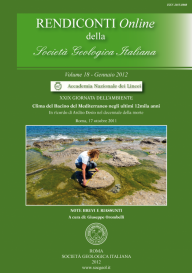
Interazioni tra clima, ambiente e uomo nell'evoluzione olocenica del delta del Tevere: dati paleobotanici e ritrovamenti archeologici
Federico Di Rita (*), Alessandra Celant (*) & Cecilia Conati Barbaro (**)
(*) Dipartimento di Biologia Ambientale, Sapienza Università di Roma, Piazzale A. Moro 5, 00185 Roma. E-mail: federico.dirita@uniroma1.it
(**) Dipartimento di Scienze dell'Antichità, Sapienza Università di Roma, Piazzale A. Moro 5, 00185 Roma.
Volume: 18/2012
Pages: 19-23
Abstract
Climate, environment and man interactions in the Holocene evolution of the Tiber delta: palaeobotanical and archaeological data.
The integration of palaeobotanical and archaeological data from recent studies carried out in the Tiber delta allows reconstructing the Holocene landscape evolution of the coastal area near Rome, revealing a long history of climate, environment and man interactions (Manfredini, 2002; D'Ambrogi et alii, 2009; Di Rita et alii, 2010; Bellotti et alii, 2011).
The geomorphological, sedimentological, palaeobotanical and archaeological data from sites located in the northern and southern sides of the Tiber delta clearly document major environmental changes, including eustatic sea-level variations, geomorphologic processes, groundwater fluctuations, desiccation events and micro-climatic processes, which have produced dramatic and repeated landscape transformations, with inevitable repercussions on the local plant biodiversity and human communities.
Human activity, documented in the area since the Neolithic and characterized by significant Eneolithic and Bronze Age settlements, appears to have had a marginal role in the landscape evolution. Only the Etruscan and Roman exploitation of the area for salt extraction produced an important impact on the landscape, becoming a major factor for environmental instability.
When considered within the last thousands of years, the modern environmental situation appears a snap-shot, destined to new, abrupt and dramatic future changes.
Keywords
Get Full Text